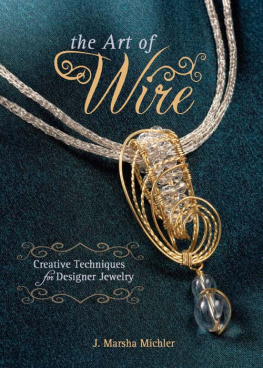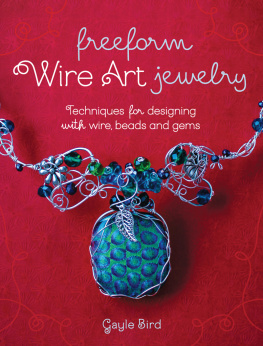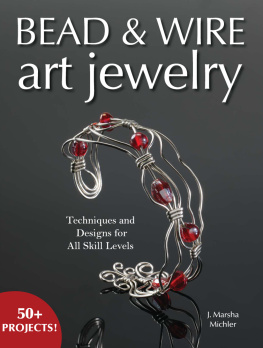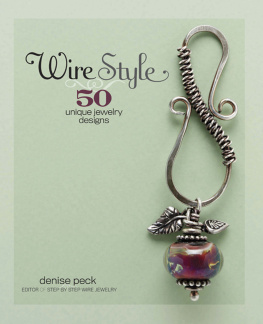Artisan Filigree
Wire-Wrapping Jewelry Techniques and Projects

Jodi Bombardier


To my #1 girl, Jules.
Thanks for all the notes of encouragement you left for me to find in my studio. Youre the best.
Contents


Marie's Earrings,

I started making jewelry in 2001. After dabbling in memory wire, stringing, and chain maille, I discovered wire and never looked back! The ways to twist and bend wire seem endless, and seeing what other artisans create with wire provides constant fuel for my creativity.
For most of my wire jewelry designs, I draw inspiration from architecture. Living in the Southwest, Im surrounded by wrought-iron fences and gates filled with scrolls. The magnificent swirls of vintage jewelry also give me ideas for wire designs.
In my research on filigree jewelry, Ive found several definitions. Here is my interpretation: Filigree jewelry is made up of fine wires shaped into intricate patterns in open soldered designs or designs soldered to a metal base. Typically, gold or silver wire is used. In Artisan Filigree, the projects involve cold rather than hot (soldering) connections. The shapes are created in heavier-gauge wire, then coiled or woven together with finer-gauge wire, and sometimes connected with jump rings, to become pendants, bracelets, earrings, and rings. Changing the orientation of the shapes creates new designs, and, in some more complex projects, several different shapes are used in a single design. In my jewelry designs, I have long used frames that are woven, coiled, or embellished in some way, so Artisan Filigree felt like a natural progression. In a couple of projects in my first book, Weave, Wrap, Coil, such as Caesars Scrolls Bracelet and Melonias Cross, you can see the beginning of this direction.
As I developed designs for Artisan Filigree, I made countless shapes of varying sizes, with different wire gauges, using both square and round wire. I would spread the shapes out on my work bench and then start playing, fitting the shapes together in various orientations and sometimes placing stones in between the shapes to see what designs evolved. Sometimes, I would take a magnificent stone and see what shapes fit around it. One example of working shapes around a stone is Janices Pendant (). When I saw a strand of golden rutilated quartz at a bead show, I just had to have it and use it in a design!
Ive worked with a variety of wire types and gauges over the years, including craft, copper, brass, sterling silver, and fine silver wire, with gauges ranging from 28 to 8. I use round, square, and half-round wire in my work. The designs in Artisan Filigree are created with craft, copper, and sterling silver wire in a mix of shapes and gauges. Please note: If a project is shown in sterling silver wire, for example, that doesnt mean that you have to use sterling silver. Have fun and use the wire type and shape of your choice! Although projects can be made with different gauges, I suggest you use the same gauge I use the first time you make a project.
The projects in this book are sorted into three categories: beginner, intermediate, and advanced. They incorporate wire-form shaping, coiling, weaving, wire wrapping, or a combination of techniques. The trick to many of these techniques is to understand how to work with your tools and how to manipulate your wire to get it to consistently do what you want it to do. See Skill Levels below to figure out which projects to try first.
So lets get the creativity going. Dig into the projects in Artisan Filigree and see what works of art you come up with. I hope you enjoy making the projects in my book and learn many new techniques!
Skill Levels
These descriptions of the projects in this book will help you decide which ones will best fit your level of jewelry-making experience.
Beginner
These projects are written to teach consistency in wire-form shaping and present a systematic way of connecting shapes together. Beginner projects are mostly made with one style of shape. Intermediate and advanced level designers will quickly grasp the construction of these pieces.
Intermediate
These projects are for someone who is comfortable with wire-form shaping, but who needs some guidance on systematically assembling the pieces. Intermediate projects include one or more shapes. If only one shape is used, the connections will be more complex than in a beginner-level project. The advanced designer may need to skim the instructions and illustrations of an intermediate project, but more than likely will be able to look at the project and understand its construction.
Advanced
These more challenging projects are for artists who are proficient with wire-form shaping, but who may need a little help understanding how the pieces are constructed.

My secret is outI LOVE WIRE. Its forgiving, it can be manipulated into just about any shape you can imagine, and it comes in a variety of materials, shapes, and gauges. I work primarily with sterling silver, copper, and craft wire. This chapter will get you started on the right path to making filigree jewelry with wire.
TYPES OF METAL
Wire comes in many different metals. For the projects in Artisan Filigree, I use the wires listed below. As you work through the projects in the book, remember that you can use any type of wirecopper, sterling silver, or craftfor any of the projects. (Some designers like to work with brass wire; because I find it too stiff and springy, I didnt use it in these projects.)
Copper Wire
I love copper wire. Its naturally dead-soft (see Wire Hardness, ) and the price is right! Keep in mind that bare copper wire can vary in color from one spool to the next. I discovered this while making a bracelet; I ran out of wire, started a new spool, and didnt notice the color difference until the bracelet was finished. You can easily ensure that this doesnt happen by using nontarnish natural-color copper wire, which has a clear coating.
Craft Wire
There are several brands of craft wire on the market. My favorite is ParaWire, a brand of non-tarnish copper wire thats coated with a color. (ParaWire also offers a natural-color copper wire that is nontarnish and a bare copper wire that can be oxidized.) The selection of colors is phenomenal. Though most of the projects in this book are shown in antique copper and vintage bronze, I used purple 18-gauge craft wire with copper 26-gauge wire for my first mock-up of Charlis Bracelet (), to which my daughter Jules responded, Awesome, Mom! Craft wire gives you the opportunity to create some fun color combinations.

















